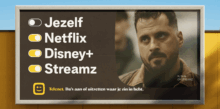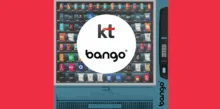Super Bundling is the ‘next big thing’ as subscribers demand greater say in content provision
by Giles Tongue

The world of subscriptions is evolving. Fast. What was once dubbed the “subscription economy” has rapidly morphed into the “subscriber economy” reflecting a power shift in favor of consumers.
The evidence is unequivocal. Consumers want access to an ever-expanding portfolio of content — not just TV and movies, but music, lifestyle, gaming, food, health, fitness and more. They also want it on their own terms, with the flexibility to switch subscriptions as the mood suits them.
For content providers providing their services as subscriptions, and for the telcos they partner with to find more customers, the arrival of the subscriber economy is a wake-up call with consumers prepared to ditch their loyalty to existing brands to satisfy their changing subscription habits.
According to research conducted by Bango in November 2022, seven in ten (72%) of subscribers feel there are too many subscriptions on the market. A third (35%) don’t know how much they spend on their subscription, while a similar amount (33%) admits to paying for something they don’t use.
It is this subscription overload — at a time when there’s also a squeeze on household incomes — that has led to consumers calling for more control over the way they manage their digital content. What’s more, they know what they want.
The research found that almost eight in ten (78%) want a single platform for all their subscriptions, with a corresponding number (77%) wanting to be able to pay multiple subscriptions in one monthly bill.
Consumers want one single platform for all their subscriptions
This evolution, from a subscription-focused to a subscriber-centric economy, is also the latest battleground in another key trend – service bundling.
The first generation of bundling, led by telcos, was based on simple one-dimensional offers that often rolled together a range of telecoms services as a bundle. Due to the liberalization of the telecoms market, mobile operators started offering fixed-line and broadband services. Broadband providers started to include mobile and fixed-line voice services.
This led to the emergence of a second generation, with telcos starting to expand their offering by working with third-party content providers to offer customers deals on services such as Netflix as part of their mobile contract.
This second-generation approach helped to catapult revenues for the streaming market to $200B, according to research by PwC, a model that forms the bedrock of today’s subscription economy.
But with demand for subscription services growing and consumer habits changing rapidly, we’re now entering the third generation — Super Bundling. Super Bundles capitalize on the second generation – which established telco networks as a credible route to market for content providers – to give end users access to potentially hundreds of content providers via a subscriptions “hub” manager, controlled by the telco brand.
With a limitless portfolio of subscriptions offered via one platform — and paid for via a single monthly payment — Super Bundles don’t just offer something that subscribers would like. It gives them something they’re demanding. And it doesn’t stop there.
Super Bundling – the opportunity
For resellers like telcos, banks, retailers, the advantages of Super Bundles are clear. According to Bango’s research, eight in ten (79%) consumers said they would be more loyal to a brand that offers Super Bundling.
Such is the appeal for greater flexibility, more than half (57%) of consumers said they would leave their current TV/broadband/mobile provider if they could get their hands on Super Bundles elsewhere.
Two-thirds (63%) of subscribers said that being given a greater say over their subscriptions would prompt them to sign up for even more services, while seven in ten (70%) said they would spend more.
The reseller benefits for telcos
Faced with a weight of market intelligence and customer insights, pioneering telcos such as Verizon and Optus have already taken the lead with Super Bundling.
In the US, Verizon +play already gives customers a choice of over 20 different subscription services available with a variety of different promotional offers over different time frames.
While in Australia, the Optus SubHub offers customers a variety of subscription services which ups the level of discount on offer depending on the number of subscriptions taken.
Crucially, although both telcos are investing in Super Bundling, each telco has approached its market with a different consumer proposition. In other words, Super Bundling doesn’t just offer choice and greater control for subscribers — it offers flexibility to telcos as well.
For telcos, Super Bundling allows them to acquire new customers attracted to an easy-to-use subscription platform, reduce churn, and increase revenue. For a crowded marketplace, it also gives them a new proposition to shake up the status quo.
Even at this early stage, Super Bundling content hubs are rapidly becoming a platform that allows telcos to engage with consumers in areas such as new product and show releases with a positive impact both on brand and customer loyalty.
Addressing the administrative nightmare
And, from the other side, for the growing spectrum of content providers — including the likes of Amazon Prime, Netflix and ESPN to YouTube, Peloton and Audible — Super Bundling provides a new way to easily reach telco customers.
For some, it offers an entirely new distribution channel that comes with the safety of a robust distribution network and leverages the trusted payment relationship that exists between telco and their customer.
The nature of Super Bundle hubs also offers content providers other advantages. Pioneers in Super Bundling are already using features such as “suspend and resume” — which allow subscribers to pause and restart subscriptions — to meet changing customer demand.
Alternatively, content providers can minimize the impact of forcing subscribers to completely cancel existing subscriptions and restart from scratch later. With Super Bundle hubs, providers can make it easy for customers to switch subscriptions within the hub, rather than cancel completely. Something that makes it much easier for customers to return as and when they choose.
Broader and deeper
Arguably, the first generation of bundling started when telcos started to add a flagship video streaming service to phone bills. Today, the latest iteration of this business model — the third generation — allows telcos to create subscriber portals rich in diverse content.
Super Bundling allows consumers to select whatever content they want — not just entertainment from the likes of Netflix, Disney+, HBO+, and Paramount, but gaming, well-being, fitness, and sport. The list is growing.
It may be early days, but Super Bundling smooths the rough edges created by the fragmentation of the subscription economy. Crucially, it addresses the needs of telcos, content providers and — most importantly — subscribers.
People will, no doubt, argue about whether Super Bundling has come about by evolution or revolution. What remains indisputable is that it’s happening now.
Subscribe to our newsletter
Get the latest subscription bundling news and insights delivered straight to your inbox.



